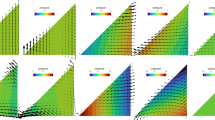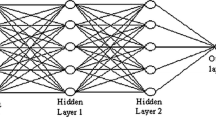Abstract
This paper considers the general stokes problems applying the Deep learning Galerkin Method (DGM) and gives the convergence of the DGM which contains two parts. First, guided by data and physical laws, depending on the \( L^{2} \) error we construct an objective function and control the performance of the approximation solution by minimizing the objective function in which the prior knowledge of PDEs and data are encoded. Then, we prove the convergence of the neural network to the exact solution. In particular, due to it is mesh free, the DGM can reduce the computational complexity and achieve the competitive results especially in face of the high dimensional problems. With this, compared with traditional numerical methods, numerical results verify the theoretical analysis and show the applicability and effectiveness of the proposed method.












Similar content being viewed by others
Data Availability
Enquiries about data availability should be directed to the authors.
References
Wang, Q., Cheng, D.: Numerical solution of damped nonlinear Klein-Gordon equations using variational method and finite element approach[J]. Appl. Math. Comput. 162(1), 381–401 (2005)
Li, J.: Numerical method of Navier-Stokes equations for the incompressible flows[M]. Science Press, Beijing (2019). (in Chinese)
Li, J., Lin, X., Chen, Z.: Finite VolumeMethods for the Incompressible Navier-Stokes Equations[M], Springer Verlag, Berlin, Heidelberg. (2022). https://doi.org/10.1007/978-3-030-94636-4
Li, J., Bai, Y., Zhao, X.: Modern numerical methods for mathematical physics equations[M]. Science Press, Beijing. (in Chinese). Acceptted
Pels, A., Sabariego, R.V., Schops, S.: Solving multirate partial differential equations using hat finite element basis functions[C]. IEEE Conference on Electromagnetic Field Computation (2016). https://doi.org/10.1109/2016.7816348
Zhao, G., Jie, K., Liu, J.: A New Difference Scheme for Hyperbolic Partial Differential Equations[C] International Conference on Computational Intelligence and Security. IEEE, (2018). https://doi.org/10.1109/CIS.2017.00102
Hornik, K.: Approximation capabilities of multilayer feedforward networks[J]. Neural Netw. 4, 251–257 (1991)
Lagaris, I.E., Likas, A.: Artificial neural networks for solving ordinary and partial differential equations[J]. IEEE Trans. Neural Networks 9(5), 987–1000 (1998)
Dazheng, F., Zheng, B., Licheng, J.: Distributed parameter neural networks for solving partial differential equations[J]. J. Electron. 14(2), 186–190 (1997)
Aarts, L.P., Veer, P.: Neural network method for solving partial differential equations[J]. Neural Process. Lett. 14(3), 261–271 (2001)
Mall, S., Chakraverty, S.: Single Layer Chebyshev Neural Network Model for Solving Elliptic Partial Differential Equations[J]. Neural Process. Lett. 45, 825 (2017). https://doi.org/10.1007/s11063-016-9551-9
Ma, C., Wang, J., E, W.: Model Reduction with Memory and the Machine Learning of Dynamical Systems[J]. arXiv preprint arXiv:1808.04258
Berg, J., Kaj, N.: A unified deep artificial neural network approach to partial differential equations in complex geometries[J]. Neurocomputing. 317, 28–41 (2017)
Sharmila, K., Rohit, T., Ilias, B., Jitesh, P.: Simulator-free solution of high-dimensional stochastic elliptic partial differential equations using deep neural networks[J]. J. Comput. Phys. 404, 109120 (2020)
Sun, H., Hou, M., Yang, Y., et al.: Solving Partial Differential Equation Based on Bernstein Neural Network and Extreme Learning Machine Algorithm[J]. Lett. 50, 1153–1172 (2019). https://doi.org/10.1007/s11063-018-9911-8
Raissi, M.: Forward-Backward Stochastic Neural Networks: Deep Learning of High-dimensional Partial Differential Equations[J]. arXiv preprint arXiv:1804.07010
Raissi, M., Perdikaris, P., Karniadakis, G.E.: Physics informed deep learning (Part I): Data-driven solutions of nonlinear partial differential equations[J]. 2017, arXiv:1711.10561
Raissi, M., Perdikaris, P., Karniadakis, G.E.: Physics informed deep learning (Part II): Data-driven discovery of nonlinear partial differential equations[J]. (2017), arXiv:1711.10566
Raissi, M., Perdikaris, P., Karniadakis, G.: Physics-informed neural networks: A deep learning framework for solving forward and inverse problems involving nonlinear partial differential equations[J]. J. Comput. Phys. 378, 686–707 (2019)
Yang, L., Meng, X., Karniadakis, G.: B-PINNs: Bayesian Physics-Informed Neural Networks for Forward and Inverse PDE Problems with Noisy Data[J]. arXiv:2003.06097v1. (2020)
Rao, C., Sun, H., Liu, Y.: Physics informed deep learning for computational elastodynamics without labeled data[J]. arXiv:2006.08472v1. (2020)
Olivier, P., Fablet, R.: PDE-NetGen 1.0: from symbolic PDE representations of physical processes to trainable neural network representations[J]. (2020). https://doi.org/10.5194/gmd-13-3373-2020
Lu, L., Meng, X., Mao, Z., Karniadakis, G.: DEEPXDE: A Deep Learning Library for solving differencial equations[J]. arXiv:1907.04502v2. (2020)
Fang, Z., Zhan, J.: A Physics-Informed Neural Network Framework for PDEs on 3D Surfaces: Time Independent Problems[J]. IEEE Access. 8, 26328–26335 (2020)
Pang, G., Lu, L., Karniadakis, G.: fPINNs: Fractional Physics-Informed Neural Networks[J]. SIAM J. Sci. Comput. 41(4), A2603-CA2626 (2019)
Raissi, M., Perdikaris, P., Karniadakis, G.E.: Multistep Neural Networks for Data-driven Discovery of Nonlinear Dynamical Systems[J]. arXiv:1801.01236v1 [math.DS] 4 Jan (2018)
Zhu, Y., Zabaras, N.: Bayesian deep convolutional encoder decoder networks for surrogate modeling and uncertainty quantification[J]. J. Comput. Phys. 366, 415–447 (2018)
Zhu, Y., Zabaras, N., Koutsourelakis, P.-S., Perdikaris, P.: Physics constrained deep learning for high-dimensional surrogate modeling and uncertainty quantification without labeled data[J]. J. Comput. Phys. 394, 56–81 (2019)
Xu, H., Zhang, D., Zeng, J.: Deep-learning of Parametric Partial Differential Equations from Sparse and Noisy Data[J]. physics.comp-ph. arXiv preprint arXiv:2005.07916. (2020)
Xu, H., Chang, H., Zhang, D.: DLGA-PDE: Discovery of PDEs with incomplete candidate library via combination of deep learning and genetic algorithm[J]. J. Comput. Phys. 418, 109584 (2020)
Shin, Y., Darbon, J., Karniadakis, G.E.: On the Convergence of Physics Informed Neural Networks for Linear Second-Order Elliptic and Parabolic Type PDEs[J]. Commun. Comput. Phys. 28(5), 2042–2074 (2020)
Sirignano, J., Spiliopoulos, K.: Stochastic Gradient Descent in Continuous Time[J]. Social Science Electronic Publishing. arXiv preprint arXiv:1611.05545
Sirignano, J., Spiliopoulos, K.: DGM: A deep learning algorithm for solving partial differential equations[J]. J. Comput. Phys. 375, 1339–1364 (2018)
Yue, J., Li, J.: The Physics Informed Neural Networks for the unsteady Stokes problems[J]. Int. J. for Numerical Methods in Fluids (2022). https://onlinelibrary.wiley.com/doi/abs/10.1002/fld.5095
Li, J., Zhang, W., Yue, J.: A Deep Learnign Galerkin Method for the Second-order linear elliptic equations[J]. Int. J. Numer. Anal. Model. 18(4), 427–441 (2021)
Ladyzenskaja, O.A., Solonnikov, V. A., Uralceva, N.N.: Linear and Quasi-linear Equations of Parabolic Type (Translations of Mathematical Monographs Reprint)[M]. American Mathematical Society. 1988(23)
Gilbarg, D., Trudinger, N.S.: Elliptic Partial Differential Equations of Second Order[M]. 2nd edn. Springer-Verlang, Berlin Heidelberg (1983)
Temam, R.: Navier-Stokes Equations, Theory and Numerical Analysis[M], 3rd edn. North-Holland, Amsterdam (1984)
Li, J., He, Y.: Superconvergence of discontinuous Galerkin finite element method for the stationary Navier-Stokes equations[J]. Numerical Methods for Partial Differential Equations 23(2), 421–436 (2007)
Boccardo, L., Dall‘Aglio, A., Gallouët, T., Orsina, L.: Nonlinear parabolic equations with measure data[J]. J. Funct. Anal. 147, 237–258 (1997)
Abadi, M., Barham, P., Chen, J., Chen, Z., Davis, A., Dean, J., Devin, M., Ghemawat, S., Irving, G., Isard, M., et al.: Tensorflow: A system for large-scale machine learning[C] in: 12th USENIX Symposium on Operating Systems Design and Implementation (OSDI 16), 265-283 (2016)
Borrvall, T., Petersson, J.: Topology optimization of fluids in Stokes flow[J]. Int. J. for Numerical Methods in Fluids 41, 77–107 (2003)
Lu, L., Pestourie, R., Yao, W., Wang, Z., Verdugo, F., Johnson, S.G.: Physics-Informed Neural Networks with hard constraints for inverse design[J]. physics. comp-ph. arXiv:2102.04626v1
Funding
This work is supported in part by NSF of China (No. 11771259), special support program to develop innovative talents in the region of Shaanxi province, innovation team on computationally efficient numerical methods based on new energy problems in Shaanxi province, and innovative team project of Shaanxi Provincial Department of Education (No. 21JP013).
Author information
Authors and Affiliations
Corresponding author
Ethics declarations
Competing interests
The authors declare that there is no conflict of interest.
Additional information
Publisher's Note
Springer Nature remains neutral with regard to jurisdictional claims in published maps and institutional affiliations.
Rights and permissions
About this article
Cite this article
Li, J., Yue, J., Zhang, W. et al. The Deep Learning Galerkin Method for the General Stokes Equations. J Sci Comput 93, 5 (2022). https://doi.org/10.1007/s10915-022-01930-8
Received:
Revised:
Accepted:
Published:
DOI: https://doi.org/10.1007/s10915-022-01930-8




